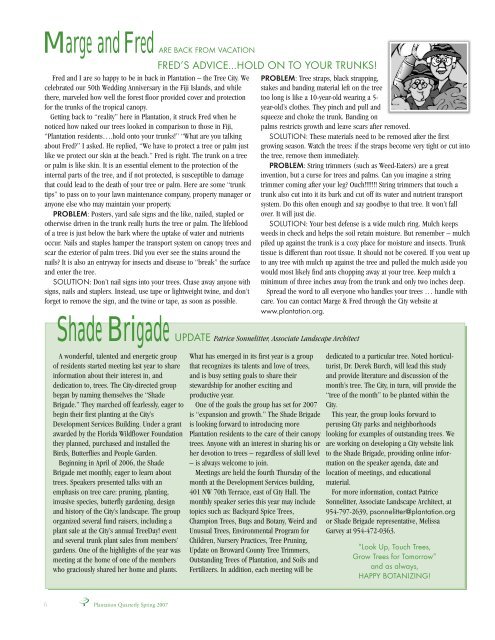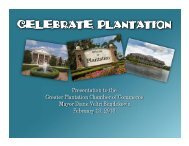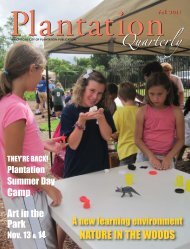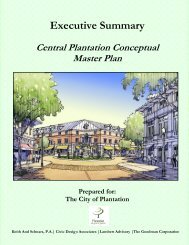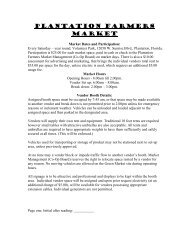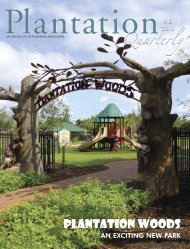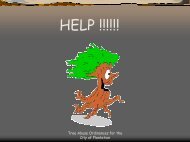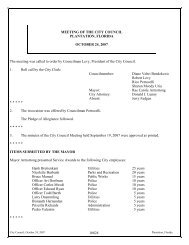Spring 2007 - City of Plantation
Spring 2007 - City of Plantation
Spring 2007 - City of Plantation
You also want an ePaper? Increase the reach of your titles
YUMPU automatically turns print PDFs into web optimized ePapers that Google loves.
Marge andFred ARE BACK FROM VACATION<br />
Fred and I are so happy to be in back in <strong>Plantation</strong> – the Tree <strong>City</strong>. We<br />
celebrated our 50th Wedding Anniversary in the Fiji Islands, and while<br />
there, marveled how well the forest floor provided cover and protection<br />
for the trunks <strong>of</strong> the tropical canopy.<br />
Getting back to “reality” here in <strong>Plantation</strong>, it struck Fred when he<br />
noticed how naked our trees looked in comparison to those in Fiji,<br />
“<strong>Plantation</strong> residents….hold onto your trunks!” “What are you talking<br />
about Fred?” I asked. He replied, “We have to protect a tree or palm just<br />
like we protect our skin at the beach.” Fred is right. The trunk on a tree<br />
or palm is like skin. It is an essential element to the protection <strong>of</strong> the<br />
internal parts <strong>of</strong> the tree, and if not protected, is susceptible to damage<br />
that could lead to the death <strong>of</strong> your tree or palm. Here are some “trunk<br />
tips” to pass on to your lawn maintenance company, property manager or<br />
anyone else who may maintain your property.<br />
PROBLEM: Posters, yard sale signs and the like, nailed, stapled or<br />
otherwise driven in the trunk really hurts the tree or palm. The lifeblood<br />
<strong>of</strong> a tree is just below the bark where the uptake <strong>of</strong> water and nutrients<br />
occur. Nails and staples hamper the transport system on canopy trees and<br />
scar the exterior <strong>of</strong> palm trees. Did you ever see the stains around the<br />
nails? It is also an entryway for insects and disease to “break” the surface<br />
and enter the tree.<br />
SOLUTION: Don’t nail signs into your trees. Chase away anyone with<br />
signs, nails and staplers. Instead, use tape or lightweight twine, and don’t<br />
forget to remove the sign, and the twine or tape, as soon as possible.<br />
FRED’S ADVICE…HOLD ON TO YOUR TRUNKS!<br />
Shade Brigade UPDATE Patrice Sonnelitter, Associate Landscape Architect<br />
PROBLEM: Tree straps, black strapping,<br />
stakes and banding material left on the tree<br />
too long is like a 10-year-old wearing a 5-<br />
year-old’s clothes. They pinch and pull and<br />
squeeze and choke the trunk. Banding on<br />
palms restricts growth and leave scars after removed.<br />
SOLUTION: These materials need to be removed after the first<br />
growing season. Watch the trees: if the straps become very tight or cut into<br />
the tree, remove them immediately.<br />
PROBLEM: String trimmers (such as Weed-Eaters) are a great<br />
invention, but a curse for trees and palms. Can you imagine a string<br />
trimmer coming after your leg? Ouch!!!!!!! String trimmers that touch a<br />
trunk also cut into it its bark and cut <strong>of</strong>f its water and nutrient transport<br />
system. Do this <strong>of</strong>ten enough and say goodbye to that tree. It won’t fall<br />
over. It will just die.<br />
SOLUTION: Your best defense is a wide mulch ring. Mulch keeps<br />
weeds in check and helps the soil retain moisture. But remember – mulch<br />
piled up against the trunk is a cozy place for moisture and insects. Trunk<br />
tissue is different than root tissue. It should not be covered. If you went up<br />
to any tree with mulch up against the tree and pulled the mulch aside you<br />
would most likely find ants chopping away at your tree. Keep mulch a<br />
minimum <strong>of</strong> three inches away from the trunk and only two inches deep.<br />
Spread the word to all everyone who handles your trees … handle with<br />
care. You can contact Marge & Fred through the <strong>City</strong> website at<br />
www.plantation.org.<br />
A wonderful, talented and energetic group<br />
<strong>of</strong> residents started meeting last year to share<br />
information about their interest in, and<br />
dedication to, trees. The <strong>City</strong>-directed group<br />
began by naming themselves the “Shade<br />
Brigade.” They marched <strong>of</strong>f fearlessly, eager to<br />
begin their first planting at the <strong>City</strong>’s<br />
Development Services Building. Under a grant<br />
awarded by the Florida Wildflower Foundation<br />
they planned, purchased and installed the<br />
Birds, Butterflies and People Garden.<br />
Beginning in April <strong>of</strong> 2006, the Shade<br />
Brigade met monthly, eager to learn about<br />
trees. Speakers presented talks with an<br />
emphasis on tree care: pruning, planting,<br />
invasive species, butterfly gardening, design<br />
and history <strong>of</strong> the <strong>City</strong>’s landscape. The group<br />
organized several fund raisers, including a<br />
plant sale at the <strong>City</strong>’s annual TreeDay! event<br />
and several trunk plant sales from members’<br />
gardens. One <strong>of</strong> the highlights <strong>of</strong> the year was<br />
meeting at the home <strong>of</strong> one <strong>of</strong> the members<br />
who graciously shared her home and plants.<br />
What has emerged in its first year is a group<br />
that recognizes its talents and love <strong>of</strong> trees,<br />
and is busy setting goals to share their<br />
stewardship for another exciting and<br />
productive year.<br />
One <strong>of</strong> the goals the group has set for <strong>2007</strong><br />
is “expansion and growth.” The Shade Brigade<br />
is looking forward to introducing more<br />
<strong>Plantation</strong> residents to the care <strong>of</strong> their canopy<br />
trees. Anyone with an interest in sharing his or<br />
her devotion to trees – regardless <strong>of</strong> skill level<br />
– is always welcome to join.<br />
Meetings are held the fourth Thursday <strong>of</strong> the<br />
month at the Development Services building,<br />
401 NW 70th Terrace, east <strong>of</strong> <strong>City</strong> Hall. The<br />
monthly speaker series this year may include<br />
topics such as: Backyard Spice Trees,<br />
Champion Trees, Bugs and Botany, Weird and<br />
Unusual Trees, Environmental Program for<br />
Children, Nursery Practices, Tree Pruning,<br />
Update on Broward County Tree Trimmers,<br />
Outstanding Trees <strong>of</strong> <strong>Plantation</strong>, and Soils and<br />
Fertilizers. In addition, each meeting will be<br />
dedicated to a particular tree. Noted horticulturist,<br />
Dr. Derek Burch, will lead this study<br />
and provide literature and discussion <strong>of</strong> the<br />
month’s tree. The <strong>City</strong>, in turn, will provide the<br />
“tree <strong>of</strong> the month” to be planted within the<br />
<strong>City</strong>.<br />
This year, the group looks forward to<br />
perusing <strong>City</strong> parks and neighborhoods<br />
looking for examples <strong>of</strong> outstanding trees. We<br />
are working on developing a <strong>City</strong> website link<br />
to the Shade Brigade, providing online information<br />
on the speaker agenda, date and<br />
location <strong>of</strong> meetings, and educational<br />
material.<br />
For more information, contact Patrice<br />
Sonnelitter, Associate Landscape Architect, at<br />
954-797-2639, psonnelitter@plantation.org<br />
or Shade Brigade representative, Melissa<br />
Garvey at 954-472-0363.<br />
“Look Up, Touch Trees,<br />
Grow Trees for Tomorrow”<br />
and as always,<br />
HAPPY BOTANIZING!<br />
6 <strong>Plantation</strong> Quarterly <strong>Spring</strong> <strong>2007</strong>


